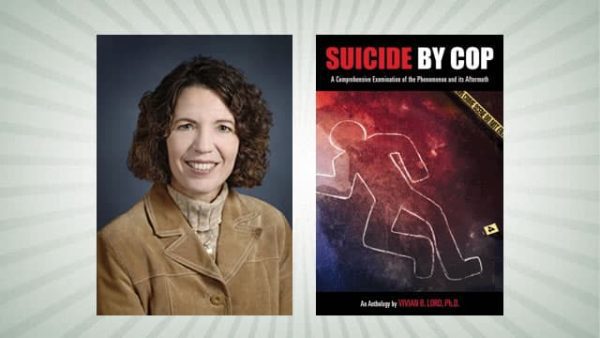New anthology chronicles ‘Suicide by Cop’

A picture of the chalk outline of a body glows starkly from the cover of Vivian Lord’s new publication, an image that underscores the gravity of the work’s subject matter.
“Suicide by Cop” is an anthology that takes a comprehensive view of civilian deaths caused by police officers and the aftermath of such incidents. It examines the psychological foundations and motivations of people who try to provoke the police into killing them and considers the appropriate criteria for classifying an incident as a “suicide by cop” (SbC).
Lord, a former police officer and current director of the School of Social Work in the UNC Charlotte College of Health and Human Services, hopes that better understanding of these incidents will help those in the field (or professions) prevent them, and when that isn’t possible, to properly manage the repercussions.
The anthology considers the process of dealing with civilian deaths caused by police officers from a range of perspectives. It looks at the effectiveness of less lethal force, the legal ramifications of a police killing and treating the psychological trauma post-incident.
“I wanted to get people to look at things differently,” Lord said of her inclusion of varying perspectives, “the idea is getting people to think.”
It’s hard to imagine a more appropriate time for the release of a book on the use of deadly force by police. The temperature of the debate on the subject has continued to climb during the last year, following a string of deadly encounters between citizens and law enforcement.
The choice to use deadly force is likely the most difficult one officers will make in their careers, and it’s a decision further complicated by the perilous circumstances in which it must generally be made. Add to that a subject who is mentally unstable or actively desires to be killed, and it’s a remarkably complex situation.
A 2004 study of 850 officer-involved shootings found that in “roughly one-third of the cases, the officer reacted to a perceived threat involving persons who suffered from mental illness, emotional distress or substance abuse.”
Having cited that statistic, Lord explained that an officer’s decision to use force is still based on relatively straightforward criteria. “Law enforcement officers are not asked to incorporate a person’s potential suicidal intent into their decision to use force,” Lord said.
Police are trained to employ a “continuum of force” that escalates based on the danger a person poses to the officer or others. Thus, it is a tragic reality that if a person acts in a way that threatens other people’s lives, the chances that the aggressor will be killed is high. It also is this reality that likely motivates so many to try to induce police to kill them in the first place.
Overall, incidents in which an officer uses force represent a minute portion of total encounters with police. “Suicide by Cop” cites a 2005 study that found of the 43.5 million people who interacted with law enforcement, only 1.6 percent reported that an officer used force.
However, the right to justifiably use violence against a fellow citizen is among the most solemn right granted in this country and given the stakes, its exercise in any number must be taken seriously.
Which is why the dearth of statistics on the exact number of and circumstances surrounding police shootings is genuinely troubling for so many.
“It is ironic that although North Americans live in the information age, when daily or even second-by-second accurate statistics are available on a variety of subjects, the precise number and descriptive details of individuals annually shot and killed by the police if often left to guesswork,” remarked co-author Rick Parent, an assistant professor at Simon Fraser University School of Criminology and a 30-year veteran of the Delta Police Department.
“This situation emphasizes the need for information sharing and the establishment of national, and international, governing bodies that would gather, research and disseminate information pertaining to the lethal threats that police face,” Parent added.
At the individual level, unequivocal determinations that a police-involved death was “suicide by cop” are rare and a challenge to reach, according to Lord. Still, “more information equals a higher probability of a confident decision,” she said.